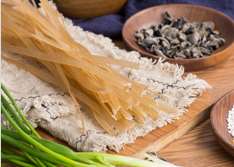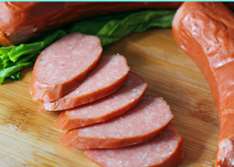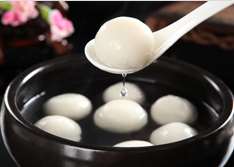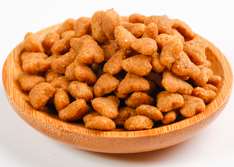Application of Compound Thickener in Noodles
Release Time:2019-05-22 14:18:53
Hits:
Noodles are one of the traditional wheaten foods in China, with large output and are deeply loved by the masses. However, with the development of economy, consumers' taste requirements for products are also increasing day by day. However, due to the low protein content of Chinese wheat and the poor quality of flour, it has an impact on the structure of gluten when forming dough. Especially in the production of colorful noodles, with the addition of ingredients, the viscoelasticity and toughness of the original dough will be affected. In the production, it is difficult to perform tabletting operation. Therefore, the strip breaking phenomenon occurs from time to time, and the products are not resistant to cooking, easy to paste soup and sticky in taste. Poor bite strength, in order to meet the needs of consumers, improve the taste of noodles, so in the process of reform, strengthen management, increase varieties, improve quality at the same time, we must also further study and discuss the noodle additives. The quality improvers commonly used for noodles mainly include emulsifiers, colloids, enzyme preparations, starches, etc. This paper mainly studied the effects of some common edible gums on the sensory and texture quality of noodles.
Edible gums used in noodles are mainly hydrophilic = sex colloids, such as carrageenan, xanthan gum, sodium alginate, guar gum, CMC, etc. Guar bean gum and CMC are easily dispersed in water and form high-viscosity colloids, which can interact with proteins in wheat flour to form a compact network structure, thus enhancing the viscosity of dough and bonding gluten and starch particles more tightly and firmly, thus enhancing the elasticity and toughness of noodles and reducing starch dissolution during cooking of noodles. Xanthan gum and sodium alginate, as macromolecular water-soluble colloids, form a network structure through the cross-linking action between their own molecules and the super-polymerization action with macromolecules, can be stable for a long time at room temperature, and has the functions of thickening, thickening and emulsifying dough; On the other hand, sodium alginate solution exists in the form of electrolyte, which can neutralize ions on gluten protein to form stable gel, thus improving the texture of dough.
In this study, sodium alginate and carrageenan were used as main materials, and compound phosphate and sodium polyacrylate were used as auxiliary materials to prepare compound improvers, which were added to flour to improve noodle quality.
1.3 Experimental Methods
1.3.1 Basic noodle formula
Flour, water, salt, compound modifier (compound kara gum, sodium alginate, sodium polyacrylate, compound phosphate).
1.3.2 Preparation of Samples
(1) Weigh and weigh 100g of flour and add 30'C of warm water. The amount of water added will increase or decrease selectively according to the situation of flour. In this experiment, 100g of flour and 34mL of water are obtained through many experiments.
(2) forming dough into loose particles without raw powder;
(3) a noodle maker for tabletting is used for tabletting, namely tabletting, tabletting and tabletting at the position where the spacing between the pressing rollers is 2mm, then the pressing roller is adjusted to 3.5mm, starting from 3.5mm, the dough sheet is gradually thinned to 1mm, a total of 6 passes are tabletted, and finally the dough sheet is tabletted at the position of 1mm and cut into slender noodle bundles with a width of 1.0mm ..
1.3.3 Determination of Noodle Quality Determination of Cooking Quality of 1.3.3.1 Noodles
(1) Determination of cooking water absorption rate of noodles
Take 40 dried noodles and weigh them on an electronic balance, and mark them M1. When the optimal cooking time is reached, the noodles are fished out, the water outside the wet noodles is drenched with distilled water, and then dried at room temperature, and then the noodles are put on a balance for weighing, which is recorded as M2.
Water absorption rate of noodles = (m2-mi)/m1 * 100%
Each group of samples were measured in parallel for 3 times, and the results were calculated by the average value.
(2) Determination of noodle breaking rate
Put dried noodles into boiling water and keep boiling for 10 min. Take out the noodles and record the number n of broken noodles.
Noodles broken rate =n/40*100%
Each group of samples were measured in parallel for 3 times, and the results were calculated by the average value.
(3) Determination of noodle dissolution rate 10g noodles are weighed and boiled in 500 mL boiling water for 15min, the noodles are fished out, 50mL noodle soup is transferred with a pipette and put into a 100 ni beaker, the noodle soup is boiled on an electric furnace until the remaining noodle soup is trace, and then the noodle soup is dried to constant weight in a dry oven at 105℃.
Dissolution rate of noodles = 50ml dry weight of noodle soup *10/ weight of cooked noodles *100%
Each group of samples were measured in parallel for 3 times, and the results were calculated by the average value.
Evaluation of Cooking Characteristics of 1.3.3.2 Noodles
(1) Sensory evaluation of noodle quality
Noodles sensory evaluation was completed by 10 members of the evaluation team who were screened and trained. The purpose of the training is as follows: first, to determine the terms describing the appearance, color, palatability, toughness, stickiness, smoothness and taste of noodles; Second, find a suitable reference standard to define the strength of each index to standardize the test procedure [.
40 noodles are put into a 2000mL beaker containing 500mL boiling distilled water, timing is started, the noodles are boiled under the condition that the water is slightly boiling at 98100 degrees, glass sheets are used for pressing the noodles, the white core of the raw powder in the middle of the noodles is observed, the noodles are quickly fished out when the white core disappears, the noodles are put into a water leakage net, and sensory evaluation personnel carry out sensory evaluation after washing with distilled water for 3 times.
(2) Determination of noodle texture
Noodles are made according to the method of 1.3.2. Take 15 cooked noodles and do 5 parallel experiments on each sample at a time. The texture of noodles was measured by CT3 texture analyzer. Determination method: 3 noodles are placed in parallel on the stage with a certain interval between noodles. The test was carried out using TA4A000 (①38.1 mm) plexiglass cylindrical probe. When placing the sample, a distance of about 10 mm is reserved between the sample surface and the bottom of the probe to ensure that the probe/sample interface can be completely disconnected and separated during the return of the probe, thus facilitating the evaluation of the adhesion characteristics of the product. The noodle texture test parameters are set as follows: mode: TPA test, test speed: 0.8mm/s, pre-test speed: 2.0mm/s, side-to-back speed: 0.8 mm/s, compression ratio 70%, induction force: 3 g, and data acquisition frequency: 100 Hz.
1.3.4 Experimental Design 1.3.4.1 Single Factor Experimental Design
Noodles were made by the above method, and the effects of compound carrageenan, sodium alginate, compound phosphate and salt on cooking quality of noodles were discussed. The design is as follows (based on 100g flour):
(1) 0.00, 0.02, 0.04, 0.06, 0.08, 0.10g/100g of compound carrageenan, 0.2g/100g of sodium alginate, 0.1 g/100g of compound phosphate and 2 g/100g of salt are taken;
(2) Sodium alginate is 0.00, 0.10, 0.15, 0.20, 0.25, 0.30 g/100g, compound carrageenan (the best condition of the above single factor) 0.06 g/100g, compound phosphate 0.1 g/100g, and edible salt 2 g/100g;
(3) sodium polyacrylate 0.00, 0.05, 0.1, 0.15, 0.2, 0.25 g/100g, carrageenan, sodium alginate according to the above best factors, composite phosphate 0.1 g/100g, salt 2 g/100g;
(4) Compound phosphate is 0.00, 0.04, 0.06, 0.08, 0.10, 0.12 g/100g, compound carrageenan (the best condition of the above single factor) 0.06 g/100g, sodium alginate (the best condition of the above single factor) 0.2 g/100g, salt 2 g/100g;
(5) Take 0.00, 0.5, 1.0, 1.5, 2.0, 2.5 g/100g of salt, 0.06 g/100g of compound carrageenan, 0.2 g/100g of sodium alginate and 0.08 g/100g of compound phosphate (i.e. the best results are obtained according to the above single factor experiment).
Orthogonal Experiment Design of 1.3.4.2
Among the five factors affecting noodle quality, compound phosphate and salt play an auxiliary role, and the main compound improvers are compound carrageenan, sodium alginate and sodium polyacrylate. Therefore, on the basis of single factor experiments, these three factors are selected as orthogonal factors, each factor is set at three levels, and U34) table is used for orthogonal experiments.
1.3.5 Data Processing
The results of orthogonal experiments were finally converted into distribution scores and then analyzed by SPSS. The distribution score is the ratio of the results of a parameter analysis to the optimal value of all the parameter results.
Results and discussion 2.1 single factor experimental results
2.1.1 Effect of Compound Carrageenan Addition on Noodle Quality Characteristics The analysis of experimental results shows that the addition of compound Carrageenan can reduce noodle breaking rate and dissolution rate, and at the same time can make noodle elasticity and hardness in the best state. The reason may be that compound carrageenan can enhance gluten strength and combine with sodium alginate to form a network structure with stable structure, so that starch can be dispersed more evenly into protein network structure and gluten tensile strength can be improved. Therefore, the network structure is added, so that the hardness of the noodles is increased, and the viscoelasticity is good, so that the noodles are not easy to break; and in the cooking process, the flour is firmly combined by the protein and the colloid network structure, so that the dissolution rate is small. According to the analysis of the experimental results, the noodles' quality characteristics are the best when carrageenan is added in the range of 0. 040. 08 g/100 g.
2.1.2 Effect of Sodium Alginate Addition on Noodle Characteristics
As shown in the figure, the addition of sodium alginate can reduce the strip breaking rate and dissolution rate of noodles. The reason is that sodium alginate forms a certain viscoelastic network structure with compound carrageenan through the action of non-covalent forces such as hydrogen bonds between main chains. This network structure can strengthen the gluten network structure, thus increasing the hardness of noodles and reducing the adhesiveness. After the noodles are cooked, the strip breaking rate is reduced and the solid dissolution rate is also reduced. However, when the added amount reaches a certain level, the hardness of noodles will be too high, which will lead to an increase in the breaking rate and affect the taste. According to the actual test, the optimal addition amount of sodium alginate is 0.2g/100g.
The hardness of noodles increases with the increase of sodium alginate, and the elasticity decreases with the increase of sodium alginate. The hardness is stable in the range of 0.15〜0.20g/100g g, and the elasticity and hardness are at the intersection at the range of 0.2 g/100 g. The real sensory evaluation shows that the chewiness of noodles in human body taste is in the best state under the hardness and elasticity. After sodium alginate is added, sodium alginate is a colloid, and non-covalent forces such as hydrogen bonds between molecules can form a network structure to reinforce the network structure between gluten protein and composite kara colloid, so that the density of the network structure of gluten is increased, and the hardness and elasticity of noodles are improved. And after adding sodium alginate, starch particles are well wrapped in the network structure formed by sodium alginate, composite carrageenan and gluten protein. However, when the addition amount exceeds 0.2g/100g, the hardness of noodles is too small, resulting in poor chewiness and too large elasticity, resulting in softening of noodles and affecting cooking performance. The optimum addition amount in the figure is about 0.20 g/100 g.
2.1.3 Effect of Sodium Polyacrylate Addition on Noodle Properties
Sodium polyacrylate can enhance the cohesive force of gluten protein in flour, enable starch particles to better combine and disperse into the network structure of protein, and form dense and stable dough colloid in combination with compound carrageenan, sodium alginate, etc. While enhancing the elasticity of dough, it can improve the organizational structure, improve the tensile resistance of dough, and increase the chewiness and adhesiveness of noodles. Experiments show that when the addition amount of sodium polyacrylate is between 0. 050. 15 g/100 g, the noodle indexes are at the best.
2.1.4 Effect of Compound Phosphate on Noodle Properties
The addition of composite phosphate has certain influence on the characteristics of noodles, because the composite phosphate between gluten protein and starch molecular main chain can undergo esterification reaction and bridging combination to form a stable composite network structure, which contains starch particles, thus reducing the dissolution rate. At the same time, gluten is strengthened, thus hardness and elasticity become stronger. The composite phosphate can be combined with the carbon chains of amylopectin to cross-link with each other, and the produced cross-linked starch has the characteristic of high temperature resistance, so that noodles are also resistant to cooking and are not easy to break. At the same time, complex network structures can also be formed between the compound phosphate, carrageenan and sodium alginate, so that the combination between the compound sodium phosphate, colloid and gluten protein is firmer, and the taste of noodles is stronger. Experiments show that the noodles have the best quality when the content of compound phosphate is about 0.07 g/100 g.
2.1.5 Effect of Salt on Noodle Characteristics
Salt has little effect on noodle quality, but adding salt to flour can also make noodles more tough, and the dissolution rate and strip breaking rate decrease. At the same time, Na+ ions have an auxiliary effect on carrageenan gelling, so salt has an auxiliary effect on noodles and composite improvers. From the experiment, we know that the best amount of salt is 1.5g/100g.
2.1.6 Effect of Compound Modifier on Sensory Score of Noodles after Cooking
According to the objective evaluation of the texture of the noodles before cooking and the dissolution rate and the objective evaluation of the texture quality after cooking, the optimal range of various factors is obtained, namely, the addition amount of the composite modifier in 100g of flour is 0.06g of composite carrageenan, 0.2g of sodium alginate, 0.1g of sodium polyacrylate, 0.07g of composite phosphate and 1.5g of salt. Of course, in daily life, people always take taste as the first evaluation scheme. Therefore, on the basis of single-factor sensory evaluation, it is necessary to make a comparison of sensory evaluation, texture properties, strip breaking rate and dissolution rate between the optimal group and the control group (without adding composite improvers). From the following table, it can be seen that the formula of the compound modifier optimized by single factor experiment is obviously better than that of the control group. In order to further refine the formula of the compound modifier, the orthogonal optimization experiment was carried out in this experiment to further obtain the excellent formula.
2.2 Orthogonal Experiment
2.2.1 Effect of Compound Modifier on Noodle Sensory Quality
From the sensory evaluation results of noodles, it can be seen that when A3B3C2, i.e. composite carrageenan is 0.08g/100g, sodium alginate is 0.25g/100g, sodium polyacrylate is 0.1g/100g, the sensory score of noodles is the highest, and the sensory quality of noodles is the most ideal.










.jpg)
.jpg)
.jpg)
.jpg)
